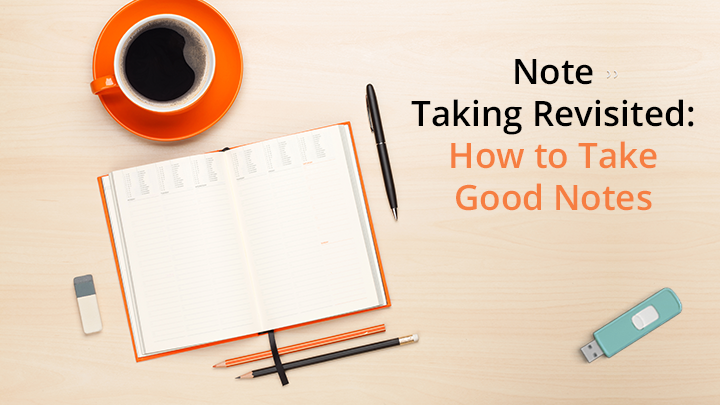Note Taking Revisited: How to Take Good Notes


Note taking should assist us when we actively process information. Writing in itself is an automatic thing; we don’t give it as much attention as we think we do. That’s why before we try to find the best way to take notes, we need to understand that the main task of taking notes. Actually, it is not to write down something word-for-word but to digest, analyze information as soon as we hear it, and then put it on paper in such a way that this process is easily recreated in our mind when we look at those notes again. To take a note of something means to pay our full attention to it; and the best note taking methods should help us do exactly this.
Note Taking Methods
How to take notes effectively? Information sinks into our minds better when we do diverse kinds of actions with it multiple times: breaking it down into categories, summarizing, finding recurrent definitions, drawing a story and then retelling it, going down the timeline and back, etc. The notes you take should present the good material for all those kinds of manipulations. They should enable a note taker to view all the pieces of information from different angles.
For this, there are different types of note taking. The choice of note taking strategies depends on the way, in which it’s easiest for you to process certain kinds of information and on the discipline you study or on the field you work in. In the end, there’s no one best way to take notes. If you use even just one that really helps you, you know how to take notes.
Disciplines and topics that have a defined structure and usually include some types of data require note taking methods that are also based on a certain structure. One of the note-taking techniques that are handy here is the chart method: you create a chart or table that has many columns, each dealing with a separate category or aspect of information. These can be the columns for numbers, dates, names, and specific features; and, thus, you just fill those columns along the way.
Liberal disciplines and abstract subjects that are generally free from fixed categories allow for more free-flowing, linear or image-like note taking methods. You can literally draw the information you receive or invent your own shorthand system to write notes. After all, you may go with the flow and draw symbols just as they come into your head when you’re listening or reading. These are actually the best notes because a touch of creativity enables a much stronger connection of the new information with your brain.
When choosing among the different note taking methods, you should also think about the things that are usually the hardest for you to remember and make them a priority in your note taking.
If you tend to memorize the specific information well when you take notes but have a hard time with recalling a general division of topics, use the outline notes method. Write down the name of a topic on the far left on the page. Then, write the names of every subtopic below a bit further to the right. Therefore, all subtopics of the same value create a column. Each step down the topic hierarchy is placed further to the right of the page, down to the key points of the smallest subtopic category. That’s how you outline notes.
A similar but more expansive method of taking notes is the mapping method, where all the elements of the matter under discussion are put on the paper to form a kind of a map, with algorithms and pointers that show how one subject relates to another. Some note taking tips: when one subject relates to many distinctive aspects of the issue, you can ascribe a different color, mind-bubble shape or handwriting size to a different aspect so that you see those distinctive connections faster.

How to Take Notes in College and Enhance Study Skills?
Many students are used to taking notes at lectures by trying to write down the lecturer’s speech in full sentences and then highlight the most important parts. However, if you tend to quickly forget what you learn, it may be hard for you to tie these highlighted pieces into the full context of the subject matter when you review those study notes. This again emphasizes the importance of reconsidering the whole notion of notetaking. Once again, the main thing here is not trying to digest information after you’ve taken your notes but to take notes of what you’ve already digested and understood, Although, highlighting still performs important functions for your study notes: for instance, you can mark the specific things like unfamiliar definitions, subjects that you’d love to study further, ideas that you find especially interesting, and so on.
One university’s method for focus notes has been around for over half a century, which witnesses its effectiveness: the Cornell note taking method. It sets a good example of how to take good notes. It’s also quite simple: a page is divided into wide and narrow columns. In the wide column, you put down blocks of notes for each aspect of the topic. In the narrow one, you put some questions that those blocks of notes answer. At the bottom, there’s a space to make a summary of all your notes on the page. Having questions, answers, and summarized points in your study notes makes it easier to check your knowledge of the subject and helps you analyze better what you write. An alternative way to use the Cornell note taking template is to write keywords for each block of notes in the narrow column instead of questions. It is very simple to apply.
How to take notes from a textbook? There are additional note taking tips to work with books and other resources, for instance, when conducting a research. You can arrange the concepts and ideas under study as an alphabetical index when you take notes and in brackets write down the page and the resource where those concepts are mentioned. It works even better if those exact mentions are highlighted in the book. You can also number the pages in your notebook and apply the indexing to your own notes.
One Key Approach to Taking Notes at Work
Work notes come in handy at conferences, brainstorming sessions, interviews, case studies for projects, etc., i.e. generally, when you’re discussing something with someone else. How to take effective meeting notes? Usually, you know beforehand what exactly the main focus of your meeting will be: finding solutions, making decisions, hiring employees, gathering ideas… You can set notetaking goals beforehand and get your mind to concentrate on those things; and you can also prepare a corresponding note taking template. You can adjust your strategy to every individual task that involves taking notes at work: prepare charts with questions and answers, create a map of the current project with blank shapes that you will fill with sketches of ideas, etc. So, if you want to know how to take effective meeting notes or any other kind of work notes for that matter – then, the main thing is to know what you’re looking for, what your objectives are.
What about technology that is now everywhere in the workspace? It goes without saying that a laptop is not a very appropriate means for taking notes when meeting people face to face. Also, taking handwritten notes is generally preferred over typing because typing is an even more automatic and detached process than mindless writing. Making voice recordings of meetings allows you to come back to the necessary information, but, in the end, you also need to write notes on that.

Some of the Best Notetaking Apps
Despite those barricade-like laptop lids, you have quite some advantages when you take notes online, especially on your phone or tablet. There are plenty of apps (and some of them have PC versions) that can show you how to take notes with ease. Here are some of the best picks:
Evernote and Microsoft’s OneNote are standard favorites, but Bear and GoodNotes are top-notch alternatives. Lucidchart and MindMeister are great for organizing notes in the form of charts and maps. If you need a creative note taking app, Notability and Squid are amazing choices. Another wonderful note taking app is an online notebook from Zoho. For bullet notes, there are Taskade and Trello, among others. In Taskade and a great app for work, Quip, which happens to deal with notes as well, you can also share your notes with others and edit them together.
How to take good notes? The best notes must evoke in your mind a full, comprehensive picture of a subject matter or its aspect. Ideally, minimum notes should contain maximum information. This means you don’t have to write all the time – remember, the most important thing is to listen and understand information; and then you put down those symbols, which will help you remember what you’ve understood so that you can work further with the material obtained. Look at your notes from different angles, re-organize them, and try to switch your tactics in the process – any of these new angles may trigger a new vision or a better understanding of the idea at hand.